
Comparisons are often made to show how one humidifier is more efficient than the other solely based on the energy required to generate steam or vapor. Little attention has been given to the impact of the humidifier on heating and cooling costs, the affect of local climate, or how utility costs can vary significantly from city to city.
In general, there are two types of humidification processes that are commonly used in our industry: isothermal and adiabatic systems. The two types operate very differently from each other, and there are many different models of each available today. There have been plenty of good articles written that describe and compare these systems in detail. This article makes a practical and operational comparison between the two types by simulating an isothermal humidifier and an adiabatic-type humidifier in the same air-handling system. Several different geographical locations are considered to evaluate the impact of the local climate as well as local utility costs.
Here are the conditions for the comparison. Assume a simple, 100% outside air, constant-volume air handler with a preheat coil, humidifier, and chilled water cooling coil. The unit operates 24/7. The design space conditions are 73 degrees F/35% rh in winter and 73 degrees/50% in summer. The temperature leaving the unit is to be maintained at 53.4 degrees.
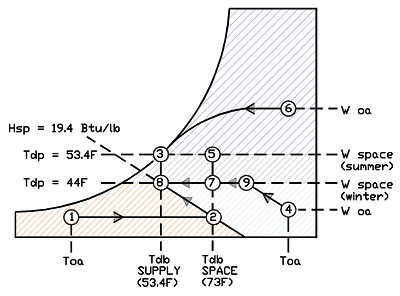
AIR HANDLER WITH ISOTHERMAL HUMIDIFIER (Steam-to-Steam Heat Exchanger)
Isothermal humidification systems utilize heat energy to generate steam and distribute it either in an air stream or directly into a room. The heat energy required is provided remotely from a boiler or locally via a self-contained system. Although the process is theoretically isothermal (constant temperature), the temperature of the air typically increases 1 degrees or 2 degrees because the water vapor is at or near steam temperature. To address IAQ concerns, demineralized or reverse osmosis (RO) makeup water is commonly used (unless the system depends on water conductivity to generate vapor).For this comparison, the steam-to-steam heat exchanger was selected to represent the isothermal group. This system generates steam through a heat exchanger using primary steam from a remote boiler.
The change in psychrometric properties of the air through preheating, steam humidification, cooling, and dehumidification are shown in Figure 1. It is assumed that the humidifier is controlled by a space humidistat. The heating and cooling coil control valves modulate to maintain the supply air temperature setpoint of 53.4 degrees.
Winter heating and humidification (Figure 1, red area) - If the outside air temperature is below 53.4 degrees and below the minimum winter space dewpoint of 44 degrees, the air is preheated (1 to 2) to 53.4 degrees before it is humidified (2 to 8). The air must leave the unit at 53.4 degrees and 70% rh (point 8) in order to maintain the winter space conditions of 73 degrees and 35% rh. The supply air is then reheated through reheat coils and by space heat gain (8 to 7) to the desired setpoint.
Sensible and latent cooling (Figure 1, blue area) - If the outside air temperature is above 53.4 degrees and above the summer supply air dewpoint of 53.4 degrees, the air is cooled and dehumidified (6 to 3) to 53.4 degrees. The air must leave the unit at 53.4 degrees (saturated at point 3) in order to maintain the summer space setpoint of 73 degrees and 50% rh. The supply air is then reheated by space heat gain and through reheat coils (3 to 5) to the desired setpoint.
Sensible only cooling (Figure 1, light blue area) - If the outside air temperature is above 53.4 degrees and below the winter space dewpoint of 44 degrees , the air is humidified (4 to 9) and cooled (9 to 8) to 53.4 degrees . The air leaves the unit at 53.4 degrees and 70% rh (point 8) as described above.
Rh dead band (Figure 1, grey area) - If the outside air temperature is above winter space dewpoint of 44 degrees and below the summer space dewpoint of 53.4 degrees, the air is either sensibly cooled or heated to maintain 53.4 degrees. The humidifier is off.

AIR HANDLER WITH ADIABATIC HUMIDIFIER (Ultrasonic)
Humidifiers using the adiabatic process exchange sensible heat of air with the latent heat of water to accomplish evaporation. The result is a drop in air temperature while the total heat (enthalpy) remains the same. In other words, moisture is added to the air at the expense (or benefit) of a drop in air temperature.When designing an adiabatic system, careful consideration must be given to the entering air temperature and humidity conditions. Since the process occurs at constant enthalpy, the air must be warm enough to absorb enough moisture to achieve the desired space rh. Therefore, the entering air typically needs to be preheated prior to humidification, especially in colder climates in systems with large amounts of outdoor air. As with isothermal systems, demineralized or RO makeup water is commonly used to address IAQ concerns. There are three general types of adiabatic humidifiers: evaporative coolers, wetted media, and water atomization.
Representing the adiabatic group in this comparison is the ultrasonic atomizing humidifier. This system generates a fine mist through high-frequency vibration of an electrically powered transducer. It was selected because of its very high operating efficiency. Recent models have demonstrated atomization of water droplets down to 1 micron, which improves absorption capability. The U.S. Department of Energy published a Federal Technology Alert on these systems, which can be obtained at (www.eren.doe.gov/femp/prodtech).
The change in psychrometric properties of the air through preheating, adiabatic humidification, cooling, and dehumidification are shown in Figure 2. The controls for the system will be a little more involved than the previous system.
Winter heating and humidification (Figure 2, red area) - If the outside air enthalpy is below the enthalpy Hsp at 53.4 degrees drybulb and 44 degrees dewpoint, the air is preheated (1 to 2) to Hsp using dewpoint control. The preheat and humidifier are controlled simultaneously to maintain the winter supply air dewpoint temperature of 44 degrees. Above this dewpoint temperature, the humidifer is off. Dewpoint control is required to make sure sufficient heat is added to the air to allow for adiabatic humidification (at constant enthalpy, 2 to 8) and arrive at the desired supply air temperature of 53.4 degrees. The supply air is then reheated through reheat coils and by space heat gain (8 to 7) to the desired setpoint of 73 degrees and 35% rh.
Sensible and latent cooling (Figure 2, blue area) - This process does not change. The air is cooled and dehumidified (6 to 3) to 53.4 degrees. The supply air is then reheated by space heat gain and through reheat coils (3 to 5) to the desired setpoint of 73 degrees F and 50% rh.
Sensible only cooling (Figure 2, light blue area) - If the outside air enthalpy is above Hsp and below the winter space dewpoint of 44 degrees, the air is humidified adiabatically (4 to 9) to 44 degrees dewpoint. It is then cooled through the chilled water coil to 53.4 degrees (9 to 8). Note that during the humidification process, there is a reduction in drybulb temperature prior to mechanical cooling. This is known as "free" evaporative cooling and could result in significant energy savings when a system is primarily used for cooling.
Rh dead band (Figure 2, grey area) - If the outside air temperature is above winter space dewpoint of 44 degrees and below the summer space dewpoint of 53.4 degrees, the air is either sensibly cooled or heated to maintain the 53.4 degrees supply air setpoint. The humidifier is off.
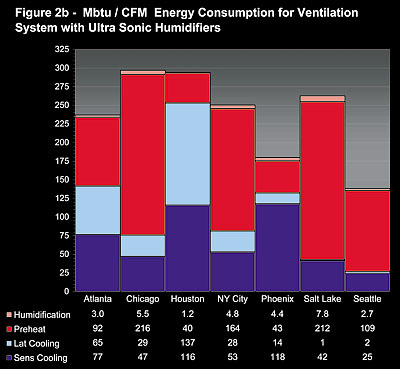
HUMIDIFICATION WATER CONSUMPTION
In a humidified building or space, moisture is constantly lost in the warm, moist air leaving the building either naturally or mechanically. The exhaust air is replaced with cool, dry outdoor air that requires moisture to maintain the desired space rh setpoint. In order to calculate the energy consumption and cost associated with a humidification system, the rate of outside airflow into and out of a building must be determined.For humidified spaces equipped with mechanical ventilation systems, the rate of outdoor airflow is given from the exhaust airflow and/or minimum outdoor air intake airflow.
For buildings without mechanical ventilation systems, the outdoor airflow from natural ventilation is usually determined from an estimated leakage rate (in air changes) through the building. The humidification load could also be impacted by moisture migration through walls, floors, and ceilings. However, when a proper vapor barrier is provided, moisture migration can essentially be ignored.
Given the fact that our model is a 100% outside air system, the humidification water consumption is calculated from the difference in humidity ratio between the outside air and the minimum winter space rh setpoint of 35% at 70 degrees using the following formula. The results in Table 1 are based on hourly calculations using the TMY2 data set provided by the National Renewable Energy Research Laboratory (NERL). This method is much more accurate than using bin data because the error associated with averaging (as much as 30% on the latent side) is eliminated.
Humidification lb/cfm = 4.5 lba/cubic ft x (Ww-Woa)
Woa = Outside air humidity ratio (lbw/lba)
Ww = Winter space humidity ratio (35% at 73 degrees space)
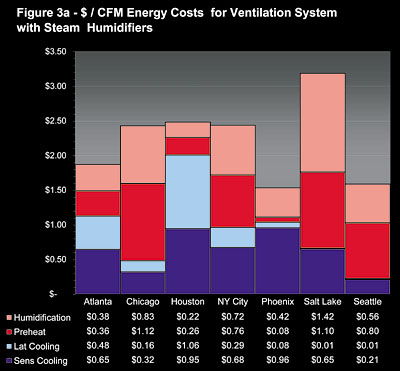
TOTAL HEATING, HUMIDIFICATION, AND COOLING ENERGY COMPARISON
The heating and cooling energy consumption associated with each system were calculated using the same TMY2 hourly data set mentioned above with the following formulas. The results, combined with the humidification water consumption are shown in Figures 3 and 4. All units were converted to MBtu's so that they can be shown together graphically.Sensible heating therms/cfm = [F x Cpa x K x (Tsp-Toa)] ?100,000
Sensible cooling ton-hrs/cfm= [F x Cpa x K x (Toa-Tsp)] ?12,000
Latent cooling ton-hrs/cfm = [F x K x Hfg x (Woa-Ws)] /12,000
K = Conversion factor (60 min/hr)
F = Air density (lbm/CF), adjusted for altitude
Cpa = Specific heat of air (.24 Btu/lbm-F)
Toa = Outside air drybulb (F)
Tsp = Drybulb supply air setpoint temperature (F)
Hfg = Heat of vaporization of water (1054.8 Btu/lbm)
Woa = Outside air humidity ratio (lbw/lba)
Ws = Summer space humidity ratio (50% at 73 degrees space)
Figures 3 and 4 show that the system with the ultrasonic humidifier consumes more heating energy and much less humidification energy than the steam system. The difference is most significant in colder climates. As discussed previously, the additional heat energy is required to increase the temperature enough (point 1 to 2 in Figure 2) to absorb the proper amount of moisture adiabatically. Less humidification energy is a result of the adiabatic process. Constant enthalpy essentially means no change in energy. The only energy consumption associated with an ultrasonic humidifier is the transducer (approximately 24 W/lb of water).
Also, less cooling energy is required with the ultrasonic humidifier due to evaporative "free" cooling (4 to 9 in Figure 2) which is most beneficial in the warmer, drier climates (like Phoenix for example).
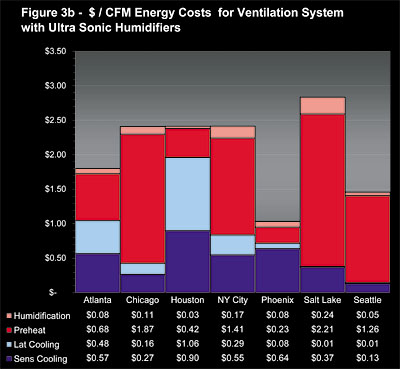
TOTAL HEATING, HUMIDIFICATION AND COOLING COST COMPARISON
Using the energy consumption data, Figures 5 and 6 show the utility cost difference between the two systems. The cooling plant operating efficiency was assumed to be 0.75 kW/ton and the heating plant efficiency is 80%. Utility costs were determined using average local utility rates in Table 2. The electrical energy required for ultrasonic humidification (obtained from manufacturers' published data) was assumed to be 24 W/lb.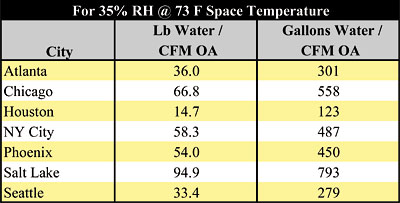
OBSERVATIONS
The local climate and utility rates have significantly different impacts on these two systems. The warmer, drier climates favor adiabatic humidifiers because less preheat is required and there is an added benefit of "free" cooling. Low heating utility rates and high electrical rates also favor adiabatic humidifiers because the heating costs can be higher and cooling costs lower. Colder climates, higher gas rates, and low electrical rates will reduce the savings.In Phoenix for example, the cost per cfm is about 30% lower for adiabatic humidification primarily because of the warmer climate. But in Seattle, the high gas rate essentially negates the energy savings in cooling and the total energy costs for the two systems are fairly close.
Also, note that this comparison was based on a 100% outside air system. Consider an airside economizer that modulates outside air with return air to maintain the supply air temperature. In a steam humidification air-handling system, the cooling energy costs would be reduced. But more outside air is required, which increases water and heat energy costs for humidification.
For an air-handling system with an adiabatic humidifier, the results can be drastically different. The reason is the evaporative "free" cooling effect of the humidifier. Because of this effect, less outdoor air is required, reducing the amount of water and energy consumed. As a result, adiabatic humidifiers offer even more energy cost savings when economizer cycles are being considered.
Heat recovery from an exhaust air system or waste heat from a process or cogeneration plant would benefit adiabatic humidification significantly in colder climates because the required preheat energy (1 to 2 in Figure 2) would be reduced or even eliminated.
There are many other factors that need to be taken into consideration when selecting a humidification system, like installation costs and space limitations. The bottom line is that every project is unique in its own way and all of the facts need to be collected. Too often, the analysis is limited to a simple "cost per lb" of water comparison, without looking at the heating and cooling cost impacts. A detailed operational cost analysis is highly recommended, especially in applications with large amounts of outside air. The results can sometimes be surprising. ES
